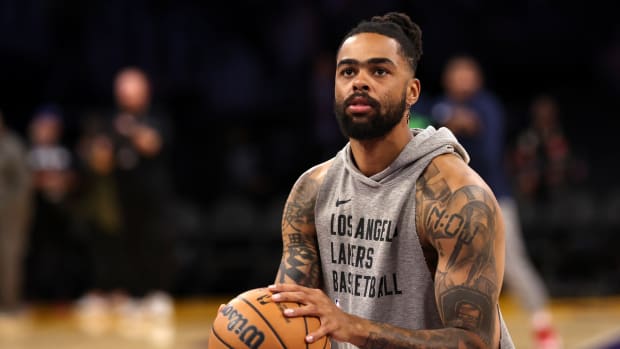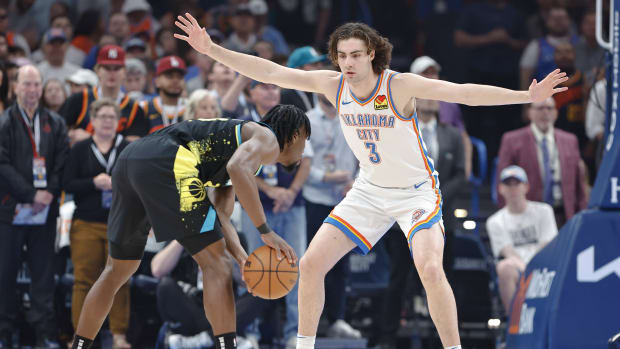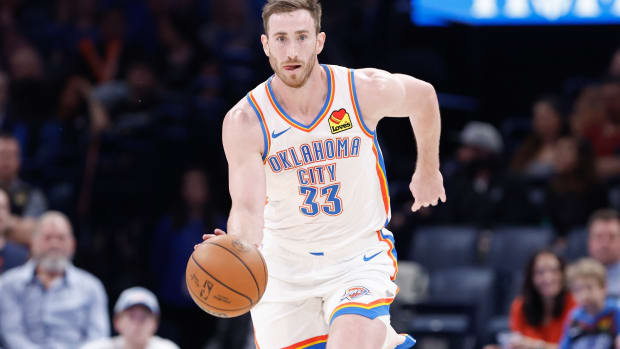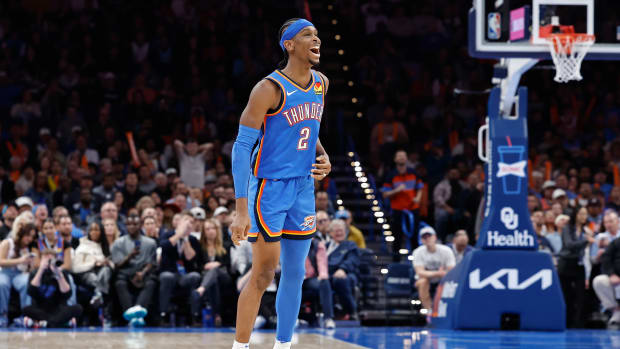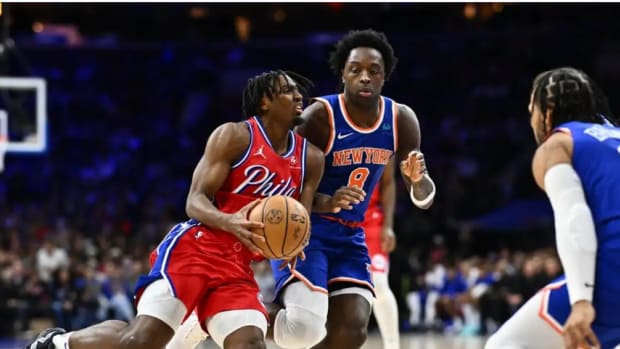What's Next in Sterling Brown's Police Brutality Case?
New court filings in the federal civil rights lawsuit brought by Milwaukee Bucks guard Sterling Brown against the City of Milwaukee and its police department suggest the 6’6, 232-pound third year player is prepared to go to trial rather than settle.
In a Nov. 27 filing to U.S. District Judge Pamela Pepper, Brown’s lead attorneys, Mark Thomsen and Scott Thompson, describe the city’s settlement offer of $400,000 as a pure “sham.” As Thomsen and Thompson see it, $400,000 is “dwarfed by the true value” of Brown’s case.
Thomsen and Thompson also reiterate the basic premise of the lawsuit: Brown claims that he was “unlawfully stopped, subject to racist language, beaten and then subsequently tasered in a parking lot.” That event, the two attorneys contend, was both degrading and dehumanizing, and one that warrants a far more significant settlement.
The attorneys also charge that the city has failed to respond to Brown’s lawsuit in good faith. To that end, they claim the city has employed “dilatory tactics” to “unnecessarily inflate” the costs for Brown to litigate the case. City officials, the attorneys assert, “were aware of their culpability for this incident, yet still waited for months after news of the incident broke to produce the exculpating body camera footage to Mr. Brown.” The attorneys further insist that the police department failed to preserve crucial evidence and, in fact, let evidence be “destroyed.”
These legal arguments reflect developments since Brown’s lawsuit was filed 17 months ago in the U.S. District Court for the Eastern District of Wisconsin. Over the last year, attorneys for Brown have engaged in pretrial discovery. They have issued, and received responses to, multiple sets of interrogatories (where witnesses answer questions under oath and in writing). The attorneys have also submitted requests for production of documents, including emails and related correspondences. Further, there have been at least nine depositions, where attorneys for Brown have asked (or plan to ask) questions of key witnesses—including the officers—while they are under oath.
Meanwhile, attorneys for the city contend that their settlement offer of $400,000 is similar, if not higher, than settlement agreements reached in comparable cases involving claims of excessive police force and violation of civil rights. As detailed below, the city identifies specific case law to support its argument. Brown, however, is under no obligation nor any rush to settle.
The incident from nearly two years ago remains disturbing
The latest court filings stem from an incident that occurred a mostly empty parking lot outside of a Walgreens in Milwaukee at around 2 a.m. on Friday, Jan. 26, 2018. With temperatures freezing, Brown illegally parked his car—a Mercedes-Benz—across two handicap spaces near the store’s entrance. He then entered the Walgreens.
Under Milwaukee law, this type of parking offense warrants a $200 ticket and a possible towing of the car. According to the Nov. 27 filing by Brown’s attorneys, one of the officers has admitted under oath that Brown only should have been issued a ticket. He should not have been handcuffed, threatened by a gun, electrocuted and shoved to the ground.
What “should have” happened and what “did” happen are two very different stories. Brown, 24, insists that several police officers applied outrageously excessive force and engaged in racist practices designed to humiliate and bully a young black man who drove an expensive vehicle.
The details of the incident, much which was captured on an officer’s Body Worn Video Camera (BWVC), are detailed in a Sports Illustrated story last year. The following is an abridged version of the key facts.
Here is how it began. After seeing a Mercedes-Benz parked illegally, a nearby officer on patrol noticed Brown leave the Walgreens and approach the car. The officer, who was white, demanded that Brown produce his driver’s license and move away from the vehicle. The officer later claimed that he was concerned Brown would jump in his car to flee. The officer also warned Brown that he “own[ed]” a right to tell Brown what to do in this situation. The use of the word “own” clearly offended Brown and led him to respond, “you don’t own me.” The officer also made physical contact with Brown. Brown objected to being touched. The officer then warned him that he needed to quit “being all bad ass.”
The officer then called for backup. Within minutes, eight Milwaukee police officers had surrounded Brown in the parking lot. Remember, this substantial presence of police was triggered only by an unlawfully parked car.
After arriving at the scene, the officers noticed that in the backseat of Brown’s car were paper targets with bullet holes in them. Those paper targets were not evidence of a crime. The Second Amendment to the U.S. Constitution protects the right to use a gun and lawfully use it on target practice. The officers then asked Brown whether he was armed. He wasn’t and he replied no. They then demanded he take his hands out of his pockets. Within one of his pockets was a key fob for his car.
The incident then became violent. Apparently believing the fob was a weapon—even though Brown had just used the fab to turn off his car’s alarm—one officer pulled a gun on Brown while another grabbed him, forced him to the pavement and kneeled into his leg. An officer then used a Taser on Brown. He screamed in pain as he was electrocuted.
Meanwhile, one officer said to another, “What is wrong with these people, man?”
Brown was handcuffed, put into a police cruiser and detained in the Milwaukee County Jail. Brown was told he faced a misdemeanor arrest. He was questioned, allegedly without a Miranda warning against compulsory self-incrimination. Brown’s car was also searched with neither a warrant nor, Brown’s attorneys insist, probable cause. Brown was eventually released without ever being charged with a crime.
Brown suffered a number of injuries during the incident. They included puncture wounds in his back and facial cuts and bruises:
Brown’s injuries did not prevent him from playing in any Bucks games or participating in any practices. Still, he felt degraded and humiliated by the manner in which he was treated.
Several of the officers involved in the incident mocked Brown. One, Erik Andrade, did so through social media. Andrade ridiculed Brown in a play on words of Anthony Davis’s “Fear the Brow” trademark line. He also “joked” about J.R. Smith double parking at a Walgreens.
This same officer also posted racist memes involving Kevin Durant:
The aftermath and lawsuit
In May 2018, the chief of the Milwaukee Police Department, Alfonso Morales, expressed that he was “sorry this incident escalated to this level.” He also acknowledged the officers acted “inappropriately.” Initially, no officers were fired or demoted, though a few received unpaid suspensions, the longest being for 15 days. Four months later the aforementioned Officer Andrade was fired.
Brown and his attorneys regarded the response by Morales and the city as wholly deficient. Morales neglected to discuss several specific aspects of the incident that Brown found uniquely problematic. They include an officer pulling out a pistol over a parking infraction, another officer jumping on Brown’s leg and the utterance of “thinly-veiled racist comments” by some of the officers.
In June 2019, Brown filed his lawsuit, which continues in litigation. He demands a jury trial and both compensatory and punitive damages. The lawsuit contains seven claims. One relies on the Equal Protection Clause of the Fourteenth Amendment and Brown’s contention that the officers treated him as an inferior citizen due to him being black. As Brown sees it, the officers noticed a young black man in an expensive vehicle and assumed he was a criminal.
Another claim is for excessive force, specifically with respect to the officers shoving Brown to the ground and using a Taser over what amounted to a parking space violation. Brown stresses that the BWVC video shows him fully complying with officers’ orders. He did so despite the officers directing racially insensitive language at him.
Brown also pleads a “Monell Claim,” which refers to an assertion that the officers were inadequately trained and supervised. To bolster that point, Brown contends that other Milwaukee police have a track record of mistreating black people. This is apparent, Brown charges, in regard to the rate at which unarmed black people are shot by Milwaukee police and through the use of “stop and frisk” practices that critics say are often applied in racially insensitive ways.
A slow case and a city’s desire to settle at terms consistent with past practices
The case has moved slowly. It could be in court for months or even years.
The court has set a deadline of July 10, 2020 for pretrial motions to be filed. The deadline could be pushed back for a variety of reasons. No trial date has been set yet. It’s possible the trial won’t occur until the fall of 2020 or some time in 2021
A trial would not necessarily be the last word, either. The verdict could be appealed to the U.S. Court of Appeals for the Seventh Circuit. It’s not inconceivable to project that, absent a settlement, Brown’s case against Milwaukee could remain unresolved until 2022 or 2023.
The City of Milwaukee hopes to gain closure much sooner. It can do so by successfully negotiating a settlement with Brown. The city recently offered Brown $400,000. As noted above, Brown and his representatives dismiss the offer as a sham and frivolous.
How did Milwaukee come up with $400,000? According to a court filing authored by Assistant City Attorney Naomi Gehling, her office “undertook significant research on jury verdicts and settlements in other cases in this circuit that involved the use of an electronic control device, or taser, by one of more police officers.” In other words, Gehling and her staff researched settlements reached in cases that are arguably similar.
In one case brought by plaintiffs Thomas Nelson and Kristin Pedersen against the Town of La Pointe, Wisconsin, Nelson and Pedersen accepted a settlement of $300,000. They argued that the town and its police chief had used excessive force and violated Nelson’s civil rights when they entered his home without a warrant, kneed him in the back, tasered him three times and dragged him to a police vehicle.
In another case, James Paquin v. City of Kiel, Wisconsin, a 17-year-old plaintiff accepted a $168,750 settlement after an officer had entered his home without a warrant, tased him twice, and caused him to fall and knock his head. The officer also tried to stop the teenager from calling his mom.
Gehling also discusses a settlement in a case called Dominique Franklin, Sr. v. City of Chicago. It involves a Walgreens and a death. The plaintiff accepted a $210,000 settlement to resolve a matter where police mistakenly thought a man had stolen from a Walgreens store, then chased and tased him. While running away from the police, the man hit his head on a light post and died.
Gehling’s filing also references a number of similar cases where a plaintiff raised similar claims as Brown won his or her trial and yet the jury awarded damages for much less than $400,000.
The basic argument raised by the city’s attorney is clear: Brown shouldn’t expect more money in a settlement merely because he is famous or wealthy. Similar, if not worse, cases have led to smaller settlements and lower jury verdicts than the dollar amount the city has offered to Brown. Gehiling therefore insists the offer to Brown was “eminently reasonable” and clearly made in good faith.
Brown doesn’t have to settle and he believes he shouldn’t take the offer
Brown is in a different position than most plaintiffs. Usually plaintiffs find settlement offers attractive because they if they accept, they then receive a swift payment, sometimes for a considerable amount of money. If the plaintiffs instead wait for a trial and a possible appeal, they could lose the case and receive no money. They might instead win the case and gain the satisfaction of “justice”—the defendant is found liable—and also receive more money than was expressed in a settlement offer. However, “winning” can take several years to play out and is subject to appeals. A plaintiff might need money sooner to pay off health and other bills related to injuries.
Attorneys representing plaintiffs are also important in this analysis. They sometimes urge their clients to take a settlement offer out of self-interest. The attorneys might be working on a contingency-fee arrangement whereby they are only paid if the case is successfully resolved by a verdict or settlement.
Brown, who the Bucks are paying $1.62 million in the ’19-’20 season and who will have earned $3.8 million over his first three seasons in the NBA, can approach the case from a more deliberate pace and empowered perspective. He earns more money than 99% of Americans. He’s obviously not a star NBA player—Brown plays, on average, 17 minutes a game as a backup guard—and isn’t paid like a star, either. However, the former SMU standout is good enough to potentially carve out a long and relatively lucrative pro career. A possible payment of $400,000 (some of which might go to Brown’s attorneys) and the risk of losing a trial or appeal and receiving nothing are likely not going to pressure Brown into accepting a settlement offer that he finds inadequate.
Wealth isn’t the only reason Brown is disinclined to settle for $400,000. As an NBA player, Brown has a public platform that positions him to amplify concerns about law enforcement’s treatment of minorities. He doesn’t have the fame of teammate Giannis Antetokounmpo, but Brown can still command the media’s attention in ways that ordinary people can’t. That is likely one reason why Brown and his attorneys demand that any settlement includes a statement from the police saying that what happened was wrong. Often settlements don’t contain a statement of admission—indeed, avoiding having to say “I was wrong” or “I’m sorry” is typically a key reason why an institutional defendant such as a city or police department agrees to settle.
Sterling Brown is also aware that he’s not the first black NBA player to have a problematic encounter with the police. In 1990, Boston Celtics rookie Dee Brown and his fiancée, Jill Edmondson, were mistakenly identified by police in an affluent Boston suburb of being robbery suspects. The officers went so far as to draw their weapons on the couple as they sat in their car reading mail. Brown was forced to exit the car and lie on the pavement. After showing his driver’s license, Brown was released and, physically, unharmed. However, the incident was obviously frightening.
Fifteen years later, Thabo Sefolosha, who at the time played for the Atlanta Hawks, was less fortunate than Brown. The Houston Rockets forward suffered a broken fibula and ligament damage to his ankle in an incident outside a Manhattan nightclub with New York Police Department officers. The incident involved an argument between Sefolosha, teammate Pero Antić, and several officers. Sefolosha, who was found not guilty of resisting arrest and obstructing justice, sued the City of New York. He eventually reached a $4 million settlement. In announcing the settlement, the City made clear that the “settlement [was] not a concession that Mr. Sefolosha was blameless in this matter and there was no admission of liability by the defendants.” The city found $4 million acceptable ''in light of the gravity of his injuries, the potential impact on his career as a professional athlete and the challenge for a jury in sorting out the facts in this incident.”
As a final point, Brown’s attorneys argue that the city attorneys’ office conveniently neglected to reference certain cases that appear relevant. One was Adams v. City of Chicago and it involved a fact-pattern from 2004. 20-year-old twin brother and sister shared an apartment in Chicago with their 18-year-old brother. While jogging, the 20-year-old male was called both a “f----- monkey” and a “f----- N-word” by officers. With guns drawn by those officers he was told to get on the ground. An officer then kicked him in the face. He was later punched in the face with a closed fist by an officer who was wearing weighted gloves. The physical abuse and racist comments continued in a police cruiser where his head was slammed against the window by officers and he was punched repeatedly in the face. He suffered numerous and devasting injuries to his face, eyes, nose and mouth. He was described as appearing “unrecognizable.” Later, when the siblings confronted the officers over what happened to their brother, one of the siblings was punched in the face and the other was hurt. The details from the case are grotesque and jarring and the resulting injuries were substantial.
A jury found in favor of the three siblings and awarded them a total of $3.7 million. Although a federal district judge initially lowered the award on grounds that it was “monstrously excessive” in light of other jury awards, the U.S. Court of Appeals for the Seventh Circuit upheld the award.
Brown’s attorneys believe the Adams case is instructive since it involved three young black people of a similar age to Brown. They, like Brown, were injured by officers. Obviously, there are differences. While Brown suffered harm, his injuries were not nearly as catastrophic as those experienced by at least one of the Adams siblings.
Chances are, Brown and the City of Milwaukee will ultimately reach a settlement and avert a trial. But given the multifaceted dynamics detailed above, determining a dollar amount that would work for all the parties and resolving whether a settlement contains an apology or admission of wrongdoing will be difficult to untangle.
Michael McCann is SI’s Legal Analyst. He is also an attorney and the Director of the Sports and Entertainment Law Institute at the University of New Hampshire Franklin Pierce School of Law.































